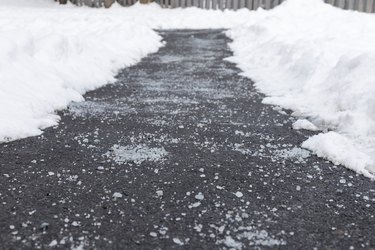
When snow and ice blanket roads and sidewalks, different salt combinations are put to work to melt the frozen coverings, making them less slippery for walking and driving. Some are more corrosive to hard surfaces and skin than others, so consider your needs when you're choosing which salt to use.
Types of Ice Melt
Video of the Day
There are four types of ice melt typically used to melt snow and ice, although not all contain sodium. The most commonly used product is sodium chloride, often called rock salt. This is the cheapest of the ice melt salts available. The biggest problem with sodium chloride is that it's corrosive and can damage wood, concrete, and plants.
Video of the Day
Calcium chloride looks like rounded white pellets. It melts snow faster than sodium chloride, is much less harmful to concrete and works well in extremely cold temperatures. It can, however, burn your skin and be harmful to your pet's paws. A more pet-safe option is magnesium chloride, although you need to use more of it. It's also less likely to eat away at concrete.
The fourth type of ice melt is potassium chloride, which doesn't harm plants. By itself, it only works above 15 degrees Fahrenheit, but if used in combination with other types of ice melt, it can work at lower temperatures.
Consider the Temperature
While you may want a pet-safe or concrete-safe ice melt option, you should also keep in mind the temperature when choosing a salt to melt ice and snow for your sidewalk or driveway. Also, keep in mind that any salt used in large quantities will seep into the porous pavement and eventually corrode it.
Rock salt melts snow and ice by lowering the temperature at which water freezes. It works best if the temperature is above 15 F and it's the cheapest option, but if you're worried about corroding your sidewalks or irritating your pets, you could mix rock salt with sand to provide traction and mitigate the corrosion effect. Potassium chloride is another less corrosive option when the temperature is above 15 F, but it's also less available.
When it's really cold, calcium chloride will do the trick. It creates heat as it turns ice and snow into liquid and absorbs moisture from its surroundings. It's safe for most concrete, but it still irritates skin and can harm pets.
Other Ice-Melting Facts
There are combinations available that some manufacturers claim are environmentally friendly. Some of these contain calcium magnesium acetate, which can be used as a coating for rock salt, making it less environmentally friendly than it seems.
A common blend for ice melt is calcium chloride, magnesium chloride, sodium acetate, and other inorganic compounds. This is an ice melt-salt combination that's less corrosive than plain rock salt and less harmful to plants, pets, and even vehicles. Instead of melting ice and snow, it prevents ice and snow from forming, so it needs to be spread before a snow or ice storm.
A 50-pound bag of rock salt costs about $15, while a 50-pound bag of the calcium chloride, magnesium chloride and sodium acetate blend is about $25. No type of salt or ice melt is good to spread for traction on ice, however. For that, sand is the cheapest, most effective, and least damaging option.